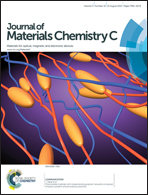Naphtho[2,1-b:3,4-b′]bisthieno[3,2-b][1]benzothiophene-based semiconductors for organic field-effect transistors†
Abstract
A novel series of air-stable and highly extended π-conjugated naphtho[2,1-b:3,4-b′]bisthieno[3,2-b][1]benzothiophene derivatives, NBTBT-n (n = 6, 8, 10, and 12) and NBTBTF-10, was developed. The influence of various alkoxy-side groups including straight chain with different chain lengths and branched chain on the FET device performance was also investigated. There was a progressive enhancement in the NBTBT-based OFET device performance with an increase in the annealing temperature. The OFET devices based on NBTBT-10 fabricated by vacuum deposition exhibited the best performance with a hole mobility of 0.25 cm2 V−1 s−1 and an on/off ratio of 105–106 after annealing at 220 °C. In addition, fluorinated naphtho[2,1-b:3,4-b′]bisthieno[3,2-b][1]benzothiophene, NBTBTF-10, showed good p-type transistor behaviour with a hole mobility of 0.24 cm2 V−1 s−1 and an on/off ratio of 106–107 which was achieved at a lower annealing temperature of 140 °C, suggesting the important contribution of the dipole–dipole interactions induced by the fluorine atoms in the molecular packing. As a result, the naphtho[2,1-b:3,4-b′]bisthieno[3,2-b][1]benzothiophene framework shows promise as a useful building block to construct organic semiconductors for next-generation high performance organic electronics.
![Graphical abstract: Naphtho[2,1-b:3,4-b′]bisthieno[3,2-b][1]benzothiophene-based semiconductors for organic field-effect transistors](/en/Image/Get?imageInfo.ImageType=GA&imageInfo.ImageIdentifier.ManuscriptID=C5TC00631G&imageInfo.ImageIdentifier.Year=2015)

 Please wait while we load your content...
Please wait while we load your content...